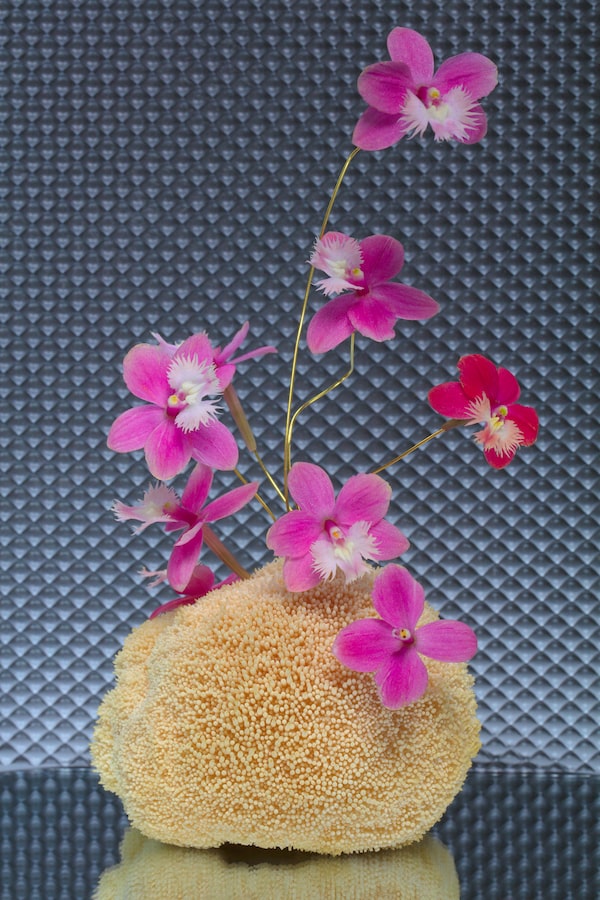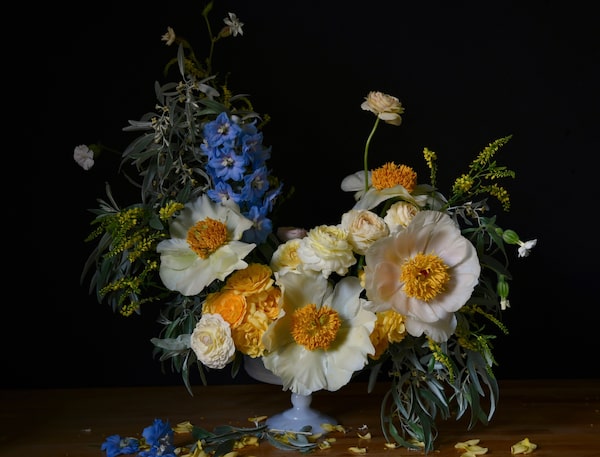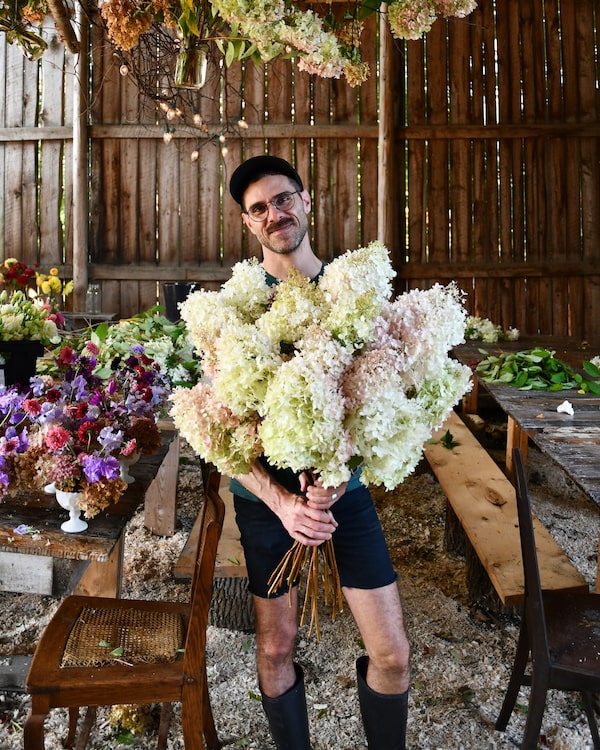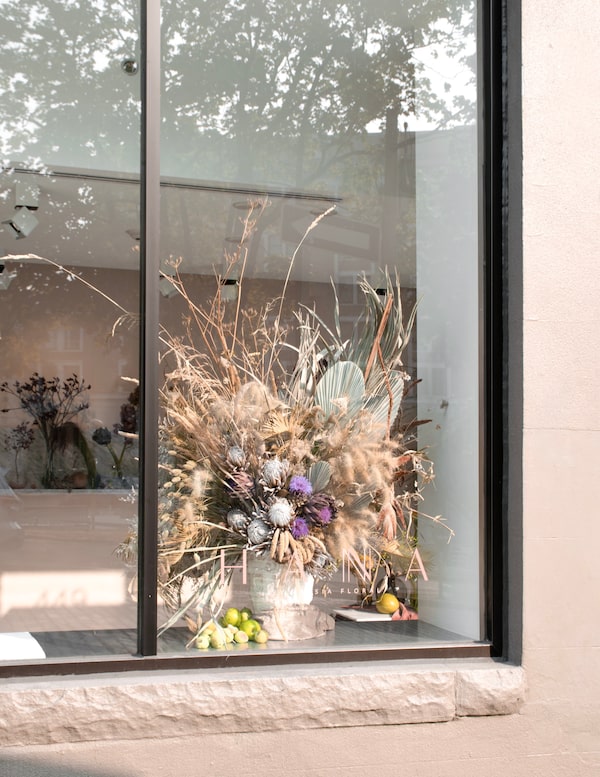
An arrangement from Lauren Wilson's Timberlost.Juliana Bird Photography/Timberlost
If art reflects current events, then the shift toward avant-garde floral design seems perfectly timed for the bizarre landscape we find ourselves traversing in 2018. The new blooms are curiouser and curiouser – wild, intentionally unstructured and much like what you’d imagine Alice discovering in Wonderland at every turn.
There’s always beauty in the breakdown, but in a more obvious way, the trend is a natural swing away from the oft-saccharine, everything-in-a-Mason-jar aesthetic that’s dominated the past decade. Even flower crowns, an accessory so mainstream that they became a Snapchat filter, have become something surreal. Cue their recent double whammy of American and British Vogue covers, featuring Beyoncé and Rihanna, respectively, in larger than life blooms.
“For the last 10 years, romantic, overflowing and organic garden-style floral design has been at the forefront of the flower movement,” says Jaime McCuaig of Toronto’s Gunnar Floral. “This wave came about as a direct response to the more rigid, structural nineties trends, and we can see this control seeping back in as minimalism, sharper lines and more sculptural movement is being experimented with again.”
McCuaig’s technicolour arrangements are emblematic of the new wave that was pioneered by Brittany Asch of Brrch Floral, an Instagram-popular New York-based florist who frequently collaborates with cult beauty brand Glossier. Asch’s blooms, which often appear in the brand’s boutiques, are often hand-dyed or spray-painted to reveal hyper-real hues.
As with so many creative fields, Instagram has contributed much to the proliferation of this movement. “Instagram was made for food and flowers. Both are highly visual and easily relatable for someone to engage with,” says Natasa Kajganic, who runs Toronto’s popular Flower Market. “As someone that follows a lot of flower accounts, you start to see a lot of the same. When you see a lot of the same as a designer, you push yourself to think outside the box and explore more of what your point of view on flowers is and try new combinations, arrangements, play with different types of vases.”
Timberlost’s Lauren Wilson, based in Toronto, attributes the proliferation of this movement to a few very practical factors, too: the invention of the “floral frog,” an alternative to foam that allows for more organic arrangements, and the explosion of ceramists who have made distinctive vessels all the more enticing to play with. Local growers, such as La Primavera, Floralora, Aldergrove Farm and Graeme Foers, are contributing, too, with increasingly inventive blooms available on Ontario soil.
“When I first became a florist, there were one or two growers doing small-scale production, but we all bought our flowers from the wholesale flower district near the airport,” she says. “Now, a variety of character-heavy blooms, greenery and grasses are at our fingertips.”
“It is an exciting time to be a florist in Toronto right now as Canadians are finally at a point where experimental, innovative and modern designs are desired and welcomed,” says Wilson.
Here, five florists leading the industry’s new look.
Gunnar Floral

Duncan Foy/Gunnar Floral
Jaime McCuaig sees her arrangements as an extension of herself: “quixotic, unconventional and playful.” The Toronto floral designer errs on the side of weird, with surreal, oft spray-painted arrangements that have been featured everywhere from the Gardiner Museum to album artwork for Cold Specks. “I am infinitely inspired by the bizarre and am constantly working to emulate a fine balance between an aesthetic that is beautiful and pleasing, but equally strange and unexpected,” she says.
Marc Sardi

Marc Sardi

Marc Sardi
A few years ago, Montreal’s Marc Sardi was in the midst of a career crisis.
While questioning the 20 years he’d spent in environmental work, he began picking wildflowers, something he’d done as a child growing up in Dollard-des-Ormeaux, Que. He was instantly transported, and after a few months of posting Dutch still life-inspired arrangements on Instagram, he launched his own naturalistic floral design company.
“I love to recreate a mini-landscape with flowers and foliage that typically grow together in a garden,” he says. Respecting natural growth patterns are essential for Sardi, “complete with tall, hidden, and cascading elements that reflect the natural movement and positions of stems, leaves and blooms.”
Timberlost

Toronto florist Lauren Wilson.Timberlost

Timberlost
Lauren Wilson launched Timberlost out of a wedding dress shop five years ago, and today, she’s one of the most in-demand florists in Toronto.
She was on the forefront of the Mason jar trend, and now she’s trendsetting again, with unstructured, undulating arrangements that make you feel as if you’re being swept up in a windstorm – in the best way possible, that is.
“Arranging is an art of balance, composition and risk,” she says. Together with illustrator Madison Van Rijn, Wilson reimaged the Prairies for Off-White’s Yorkville store opening last year, with 30 metres of dried grasses.
This year, she opened her first physical shop, Solidago, through which she offers a subscription service of customized arrangements.
Hana by Celsia

Hana by Celsia
Johanna Siu launched Hana, a subset of her already successful Vancouver floral design company Celsia, last year as a way of connecting the dots between conventional gigs (read: weddings) and a growing interest in flowers from the design-minded community. “As artists, we are inspired by the opportunity to design in different contexts and found the floral style that was being well received by these new audiences was more conceptual and modern,” says Siu. Among other things, Hana offers conceptual installations, plant walls and seasonal fresh cuts that she describes as “minimalist, intentional and artistic.”
White Oak
“There was a time where I would scroll through Instagram and everything looked the same. It drove me mad,” says Jordan Masi. “I think a lot of us just tried to make really strange things to try and shake it up. I think it’s working.” What constitutes “strange” has certainly worked for the Toronto florist, who has amassed more than 15,000 followers on the same platform for her wild, unexpected arrangements of foxglove, hellebore, bearded iris and more. “Shape, depth, tone, scale. To me, the most affective way to make a statement is to utilize these elements,” she says.
Visit tgam.ca/newsletters to sign up for the Globe Style e-newsletter, your weekly digital guide to the players and trends influencing fashion, design and entertaining, plus shopping tips and inspiration for living well. And follow Globe Style on Instagram @globestyle.